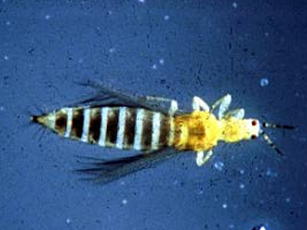
R. Chris Williamson, Turf and Ornamental Specialist
Revised: 4/25/2004
Item number: XHT1022
Western flower thrips, Frankliniella occidentalis, are likely the most serious pest of greenhouse crops in the world. Thrips have spread throughout the horticulture industry on plugs, cuttings, and small plants. Because of thrips’ small size (1∕16 inch) and tendency to remain hidden in flower buds, they are difficult to detect before severe feeding damage is evident. Thrips cause damage to greenhouse crop in several ways: directly by their feeding and egg laying activities on plants, and indirectly by acting as vectors for tospoviruses.
Plants Attacked and Damage: Thrips have a relatively broad host range, feeding on greenhouse crops such as carnation, chrysanthemum, fuchsia, geraniums, hibiscus, impatiens, ivy, marigolds, petunia, roses, and verbena. Thrips feed by piercing plant cells with their mouthparts and feeding on the exuded plant juices. The collapse of plant cells due to feeding often results in deformed flowers, leaves, and shoots. Silvery flecked scars or small black “fecal” spots also may be seen on the expanded leaves. In addition to direct feeding damage, thrips may cause indirect damage by vectoring (spreading) two closely related tospoviruses [impatiens necrotic spot virus (INSV) and tomato spotted wilt virus (TSWV)] to uninfected plants. These tospoviruses have wide host ranges, affecting over 600 plant species in 62 families. Growers of begonia, cineraria, cyclamen, exacum, gloxinia, impatiens, New Guinea impatiens, primula, and ranunculus have experienced substantial losses due to these viruses. Young plants can be especially susceptible to infection and there is no cure once infection has occurred. Immediate roguing of infected plants should be combined with strict thrips management to prevent serious losses.
Life Cycle and Biology: Most thrips in greenhouses are females. Adult females live for approximately 30-45 days and lay 150-300 eggs that are inserted into plant tissue. Eggs can be laid on the upper or lower leaf surface, depending upon the plant species, and thus, targeting pesticide applications to the area when and where thrips are located is important. The first two thrips larval stages remain protected in the tender young plant tissue. Eventually, second instar larvae stop feeding and drop into the soil or other growth medium to pupate (transform into the adult). Adults emerge two to five days later, depending on temperature.
The thrips life cycle is dependent on temperature, with development occurring between 50 and 90 degrees F. Thrips can survive temperatures below 50 degrees F. However, they do not develop at this temperature. The thrips life cycle vary in length from seven to 14 days at fluctuating temperatures between 68-98 degrees F that are common in most greenhouses.
Control: The most effective thrips management strategy is to prevent thrips form entering greenhouses. Monitor for adult and larval thrips as soon as young plants or cuttings are received. When possible, keep thrips-infested plants isolated in a separate area to avoid spread. Although winged adults are relatively weak fliers, they can be carried on air currents or on employees’ clothing. Consider worker movements to and from highly infested greenhouses, and avoid wearing clothing with colors (e.g., pink, blue, yellow, white, or green) that are attractive to thrips. .
Both chemical and biological control strategies are available for thrips control. However the bottom line is that there are no easy answers for thrips management. Chemical control of thrips is difficult because thrips tend to hide in flowers and buds, they have a rapid life cycle with a high reproductive rate, they have a wide host range including many weed species, and there is widespread resistance to numerous chemical control products. When applying insecticides for thrips control, use a droplet size that is less than 100 microns in diameter to attain more effective contact. Also, apply insecticides every two to three weeks before peak thrips activity to ensure control of adults before they begin to lay eggs. The interval between applications may vary between three and seven days depending on the temperature, relative numbers, and stage of the crop. When selecting control materials, rotate between classes of insecticides to help delay the development of resistance. Research suggests using a material or a combination of materials for one generation (two to three weeks), then switching to an insecticide in another class. There is no single pesticide that will provide total thrips control. Abamectin and methiocarb are the most effective control products registered for thrips. Other products that provide some control are azadirachtin, cyfluthrin, acephate, endosulfan, and fenoxycarb. Tank mixes of abamectin, azadirachtin followed by a fenoxycarb spray have provided good control.
The use of biological controls (natural enemies) against thrips has been used in greenhouse vegetable production. The potential exists for biological control to be part of an IPM strategy for thrips control in ornamentals. To be successful, become familiar with thrips monitoring, and the use of environmentally friendly or “softer” control products such as botanicals and insect growth regulators (IGR’s).
For more information on thrips: Contact your county Extension agent.
Additional Images
Download Article






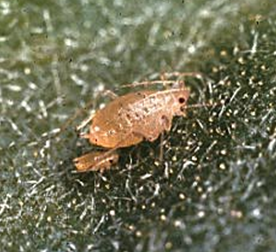 Managing Aphids in Greenhouses
Managing Aphids in Greenhouses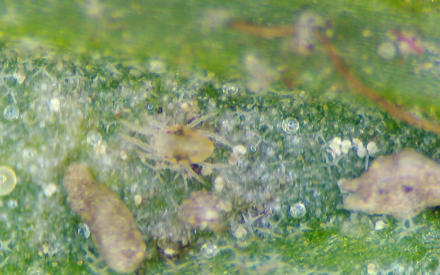 Managing Mites in Greenhouses
Managing Mites in Greenhouses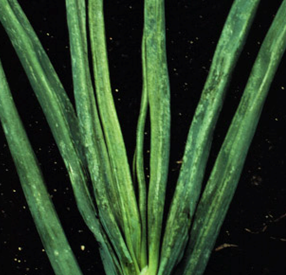 Onion Thrips
Onion Thrips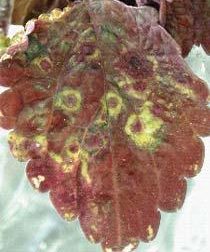 Impatiens Necrotic Spot
Impatiens Necrotic Spot


